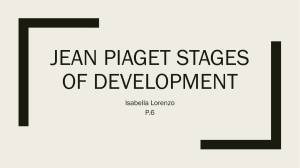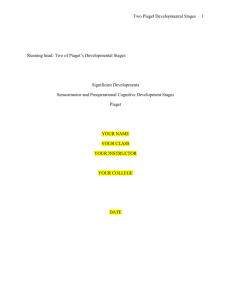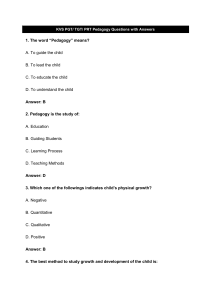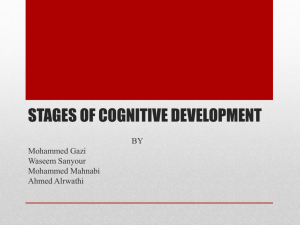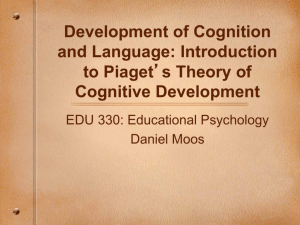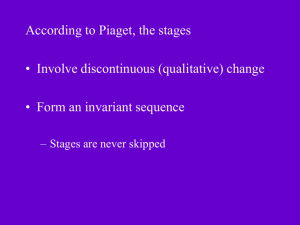early childhood - Piaget
advertisement
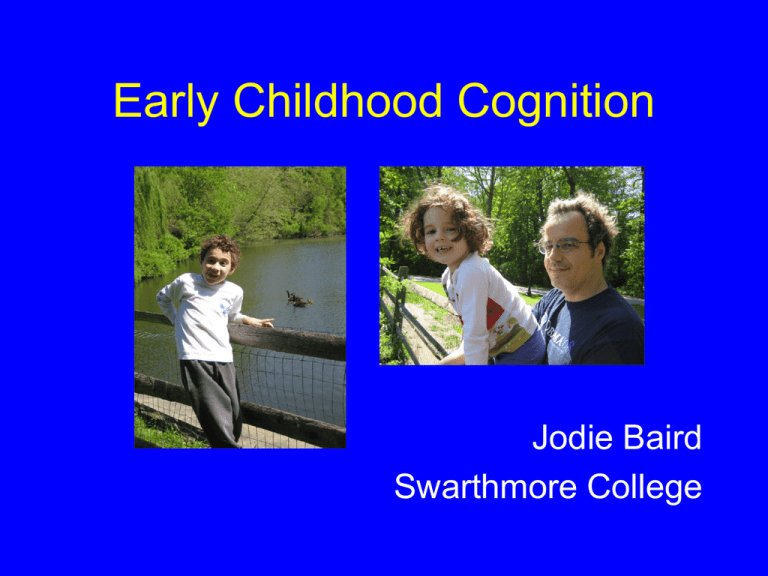
Early Childhood Cognition Jodie Baird Swarthmore College Piaget’s Theory of Cognitive Development Jean Piaget (1896-1980) Swiss psychologist Father of modern cognitive developmental psychology How do children develop knowledge? According to Piaget • By acting upon the world • By revising theories of the world – assimilation and accommodation • In stages – qualitative change – invariant sequence – universal Piaget’s Stages • Sensorimotor (birth - 2 years) • Preoperational (2 - 7 years) • Concrete Operational (7 - 11 years) • Formal Operational (11 years - adult) Piaget’s Stages • Sensorimotor (birth - 2 years) • Preoperational (2 - 7 years) • Concrete Operational (7 - 11 years) • Formal Operational (11 years - adult) Limitations of Preoperational Thought • Centration • Egocentrism • Appearance as reality Centration • Focusing on one aspect of a problem, ignoring other relevant aspects • Example: – Conservation Conservation of Number Conservation of Liquid Egocentrism • Thinking everyone sees things the same way you do • Difficulty taking another’s perspective • Examples: – Three-mountains task – Egocentric speech Three Mountains Task Child is asked to pick the picture that shows what the diorama looks like from the partner’s point of view. Egocentric Speech • Child and partner - separated by a barrier - have identical sets of cards • Child has to describe one card to the partner “It’s the dinosaur!” “The one with a tail.” Appearance as Reality • Tendency to confuse what something looks like with what it really is • Example: – Fear of Halloween costumes Appearance as Reality Strengths of Preoperational Thought • Symbolic representation • Pretend play What is a Symbol? A symbol is any entity that someone intends to stand for something other than itself. Words Numbers Pictures Maps Models Symbolic understanding requires • Awareness of relation between symbol and referent • Mapping corresponding elements from one to the other • Drawing an inference about one based on knowledge of the other Children’s Understanding of Scale Models Judy DeLoache • Real room and a model of real room • All details are identical except size • Experimenter hides Snoopy in model • Child is asked to find Snoopy in real room Can children find Big Snoopy? • 3-year-olds CAN (77% correct) • 21/2-year-olds CAN’T (15% correct) Why do 21/2-year-olds fail? • Not a memory problem • Perhaps a problem of dual representation Evidence for Dual-Representation • Decrease physical salience – e.g., photograph instead of model – better performance • Increase physical salience – e.g., encourage interaction with model – worse performance • Eliminate need for symbolic understanding – e.g., shrunken room (DeLoache, Miller, & Rosengren, 1997) – better performance Why does it matter? • Education – Objects to represent abstract concepts • Legal System – Anatomically correct dolls
